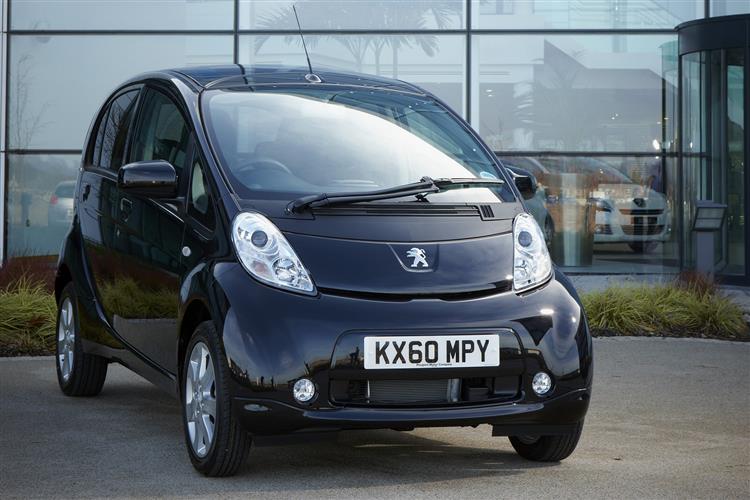LION CHARGE (some text hidden) --NONE--
By Jonathan Crouch
Introductionword count: 93
Full-electric cars are still in their infancy but in the 21st century's second decade, several affordable ones arrived on the market. Models like this one, Peugeot's iON. The French brand claimed that switching to this citycar-sized runabout from something conventional would be pretty painless. They even reckoned that despite the premium outlay required, the right kind of buyer will find that ownership costs add up. And of course, the eco-benefits speak for themselves. Few believed the brand's claims when this car was new. But does it make sense on the BEV used market?
Modelsword count: 4
5dr Supermini (BEV [47,64,67KW])
Historyword count: 223
Peugeot is a maker with plenty of track record in this form of propulsion, with an electric history going all the way back to the VLV model of 1941, several hundred of which found their way onto the streets of Paris. In the years since, they've sold more electric cars than any other manufacturer, selling over 3,500 battery-charged versions of their little 106 hatchback between 1995 and 2003. Very few of those though, reached the UK and even fewer reached the hands of private buyers. The brand hoped that things would be different with this car, the iON, launched in 2011. This was a very different car from any electric vehicle Peugeot had bought us to date. The iON made good use of the then-new lithium-ion battery technology, clothing said battery and the associated electric motor in a design shared with both Citroen (the C-ZERO) and Mitsubishi (the i-MiEV). This citycar-sized ION took on these rivals, Nissan's larger all-electric LEAF model and the 'E-REV' or 'Extended Range Electric Vehicles' then on offer from Vauxhall and Chevrolet that offered less battery range but backed it up with emergency petrol power. The ION started out in 47KW form, but was later upgraded with a 64 or 67KW powerplant. It sold until 2020. So how does it stack up as a used buy? Let's find out.
What You Getword count: 450
This ION certainly won't put off any prospective buyers with its very conventional looks. It's clearly a little sub-supermini citycar, if a rather high-sided one. At 3.5m in length, it's more akin to Peugeot's 107 of this period in size than the company's 207/208 supermini, though the 1.6m height makes it feel pretty big inside. If you find that high-sided look very Japanese, you're absolutely right. This is essentially a Mitsubishi, Peugeot and their PSA group partners Citroen having turned to the Oriental brand for help in sharing the massive development costs of this car. The Japanese maker was looking for development shortcuts too, basing this model on its Mitsubishi i, a conventionally powered city runabout with a design dating back to before 2007. Having to base this thing on a little citycar wasn't ideal for Peugeot. Whereas in this era, rivals Nissan could point to a relatively small price gap between a top-spec diesel Focus-sized family hatchback and their comparably-sized all-electric LEAF model, the French maker acknowledged that there was a yawning price differential between the cost of an urban runabout like their 107 and this ION. But they did point out that within the confines of its compact dimensions, this car offers a surprising amount of space inside. True enough, it does feel surprisingly airy inside. Certainly the cabin is narrow as it has to be given that the car is under 1.6m wide but unless you're trying to transport a trio of rugby players, you shouldn't feel it too much. At the wheel where you sit rather higher than some drivers might like, you shouldn't expect especially high standards of fit and finish. Still, the Japanese production line screwed everything together pretty well and ergonomically, the layout is sound, with excellent all-round visibility. Taking a seat here for the first time, the only clue most would have that this was not conventional petrol powered citycar would be the fact that the dash displays a petrol pump with, somewhat oddly, an electric plug hanging out of it. Is that better or worse than using a mobile phone when topping up? We're not sure. As for rear seat room, well thanks to the fact that the propulsion system is very compact and the underfloor batteries don't impinge too much on cabin space, there's enough space for two adults - or even three children - to feel quite comfortable on the kind of short to medium journeys this car will be making. Boot space is pretty limited though, with just 166-litres below the parcel shelf. Of course though, if you're not using the back seat, you can push forward the 50/50 split-folding rear seats to free up much more space.
To see the full road test text contact us on 0330 0020 227
Pictures (high res disabled)

Scoring (subset of scores)
Category: Hybrid, Plug-in, Electric & Hydrogen
| Performance | |
| Handling | |
| Comfort | |
| Space | |
| Styling, Build, Value, Equipment, Depreciation, Handling, Insurance and Total scores are available with our full data feed. | |



